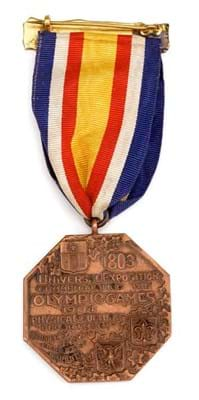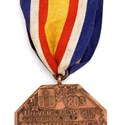The Summer Games held at Francis Field on the campus of Washington University in St Louis from August 29 until September 3, 1904, are officially known as the third Olympiad - but it was hardly an auspicious occasion. It was the first time the Olympic Games were held outside Europe. It was also the first where outstanding athletic achievement was rewarded by gold, silver and bronze medals for first, second and third place (in Athens in 1896 and Paris in 1900 the winner had received a silver medal and an olive branch).
And, from George Eyser, a gymnast with a wooden left leg who won six medals, to the Milwaukee Meteor, Archie Hahn, who ran the 200m in 21.6 seconds (a record that would stand for 28 years) there were memorable performances.
But, wrested away from the original hosts, Chicago, and held as a sporting adjunct to the St Louis World's Fair in the centenary year of the Louisiana Purchase, it was poorly attended.
With limited funding made available, and tensions in Europe running high with the onset of the Russo-Japanese War, even the International Olympic Committee founder, Pierre de Coubertin, opted to stay at home in Paris (and US President Theodore Roosevelt didn't attend either).
Official Records
Precise figures vary among sources (some of official records have been lost), but it is thought that the participants totalled 651 (645 men and six women) with just 52 athletes, representing only 12 countries, competing from outside of North America.
Needless to say, with more than half of the events including only US athletes, the host nation took 78 of the 96 gold medals on offer.
This all goes a long way to explaining why memorabilia from the 1904 games is extremely scarce and why the participation medal is missing from most 21st century collections.
Participants' medals (not to be mistaken for the trio of winners' medals) have been given to athletes and officials since the very first modern games. Half-a-dozen medals are identified as rarities, including Chamonix 1924, Lake Placid 1932 and Stockholm 1956, but St Louis is undoubtedly the most desirable.
Original Medal and Ribbon
Just how desirable was seen at Freeman's sale of American Furniture, Folk & Decorative Arts in Philadelphia on April 18, 2013 where a 1904 medal rubbed shoulders with a more typical selection of painted chests, fraktur and weathervanes. The octagonal design made by New York jewellers Dieges & Clust is well known from the collecting literature and from replicas that, on their own, can command something in the region of $500.
The obverse is a nude male, mid-stride, clutching a laurel branch, the sun rising over his shoulder. To the reverse are the Olympic legend and the crests of St Louis, France and the United States against a background of ivy.
Adding further appeal to this example was an original ribbon inscribed, Aug. 29-31, Sept. 1-3, 1904 and a bar impressed, Hon. Official. According to the consignor, it probably belonged to Samuel Morse Felton, Jr (1853-1930), who graduated from the Massachusetts Institute of Technology in 1873 and went on to become president of various railroads, including the Alton and St Louis Railroad and the Chicago Great Western Railway. He is listed as a member of the Transportation Committee for the Louisiana Purchase Exposition and in this capacity received his medal.
Estimated at $3000-5000, it took $25,000 (£16,650).
The buyer's premium was 25%.








